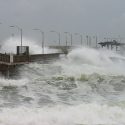Suomi remembered for problem-solving ability, drive
Verner Suomi’s career — even his life — may not have been as long and illustrious had he not been an inveterate problem solver.
As the story goes, many decades ago the father of modern meteorology was on a fishing trip not far from his birthplace in northern Minnesota. Several days from where he put in, a chance encounter with an underwater rock or stump ruined the propeller on his motorboat. Suomi was alone and many miles over water from his car and civilization.
“He fashioned himself a new propeller out of wood he was able to find,” said Eric Suomi, one of Verner’s three children. “But the first time around he got the pitch of the blades wrong, and the boat went in the wrong direction.”
That’s right: “The first time around.”
“Well, once he figured out what was wrong, he made one that worked the way he’d planned,” Eric said. “And off he went back to the boat landing.”
Born Dec. 6, 1915, in Eveleth, Minn., Verner Suomi studied engineering at a teacher’s college in Winona, Minn., and taught high school science until his experience in the Civil Air Patrol sparked an interest in meteorology.
“He was very handy,” said Eric, who is an electrical engineer. “That’s what got him into the field he’s in. Working on radios and weather equipment got him into meteorology before the start of World War II.”
Suomi had already been a member of the faculty in the new meteorology department at the University of Wisconsin–Madison for nearly five years when he finished his doctorate at the University of Chicago in 1953. His dissertation on heat coming and going from a cornfield was a stepping-stone to measuring the heat budget of the entire Earth. And that was the puzzle that boosted his work into orbit, where he could look back down on the planet.
“People recognize him as initiator and idea guy, a pioneering a guy who got things done,” said Steven Ackerman, University of Wisconsin–Madison atmospheric scientist, director of the Madison-based Cooperative Institute for Meteorological Satellite Studies and a colleague of Suomi’s before Suomi died in 1995. “He put UW–Madison on the map, and we’re still working on satellite meteorology here because of his tireless work to advance the science and learn more about our atmosphere.”
By 1959 Suomi and fellow professor Robert Parent’s experiment to monitor the Earth’s heat budget was aloft with the satellite Explorer 7. In 1966, the ATS mission carried Suomi’s spin-scan camera, which produced continuous pictures of a swath of the Earth and enabled weather monitoring by satellites whose orbit kept them perched above a single point on the planet.
“We had a receiving station at our house in Madison,” Eric Suomi said. “He would take data from the satellites during flyovers, record them on audio tape and take them in to his office where they could use the data.”
Similar data from U.S. weather satellites is still freely available to those with proper receivers.
“He was the pioneer for so many things,” said Hank Revercomb, director of UW–Madison’s Space Science and Engineering Center, which Suomi helped establish in 1965. “He foresaw concepts for pivotal instrument designs, but also how to process this valuable weather information you’re collecting and how to make it available.”
And he recognized its practical value.
“He wanted to understand how the atmosphere worked, and he pushed for advances in satellite meteorology to do that,” said Eric Suomi, who has a two siblings — Lois and Stephen. Verner’s wife, Paula died in 2005. “But he understood how important information about the weather is to the world. He knew he could help save lives in the case of severe weather, and that drove him, too.”
His drive — he continued his research even after retiring in 1988 — led to a long list of awards: a National Medal of Science in 1977, the Franklin Medal in 1984, the Charles Franklin Brooks Award from the American Meteorological Society in 1980, election to the National Academy of Engineering in 1966 and many more.
“He was a spectacular guy. Master of the one-liner. Master of seeing innovative ways to solve problems,” Revercomb said. “And a real champion for science. Above all, he wanted us to know more about our planet, and he wanted to figure out how to make that happen.”

